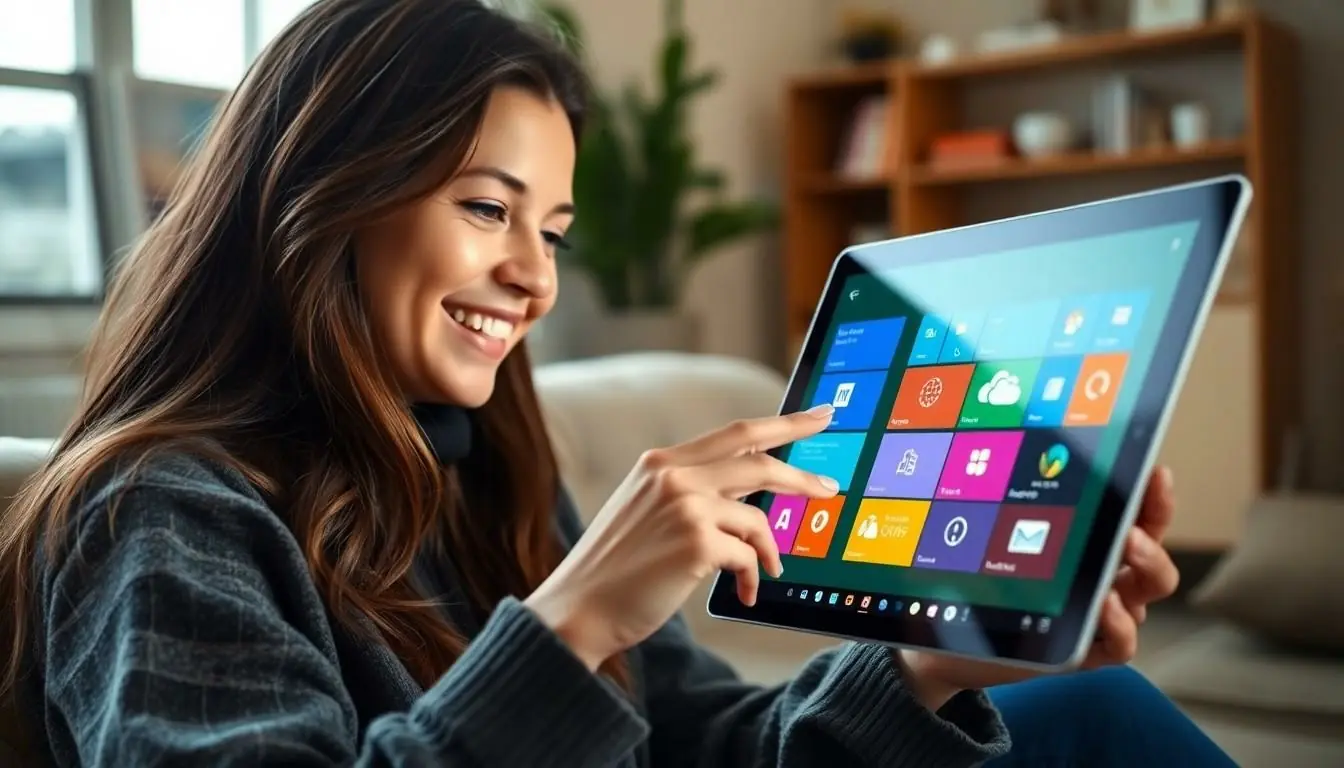Windows 11 has redefined the way users interact with their devices, and its tablet mode is a game changer. Imagine transforming your laptop into a sleek tablet with just a click—perfect for binge-watching your favorite shows or sketching your next masterpiece. It’s like having a Swiss Army knife in your tech arsenal, ready to adapt to your needs.
Table of Contents
ToggleOverview of Tablet Mode Windows 11
Tablet mode in Windows 11 transforms a device’s interface for touch interactions. Users can switch easily between desktop and tablet modes, enhancing flexibility. This feature is tailored for individuals using 2-in-1 devices, blending laptop performance with tablet convenience.
With larger touch targets, Windows 11 focuses on improving navigation. Gestures such as swiping and tapping facilitate seamless browsing and application use. Additionally, apps adjust automatically, providing a more engaging experience for digital drawing and note-taking.
Users notice a simplified taskbar when tablet mode is activated. Icons enlarge, and the interface shows fewer distractions, promoting a user-friendly environment. Notifications become more accessible, aiding users in staying updated without hassle.
Accessibility features in tablet mode also stand out. Voice commands and touch capabilities improve interaction for individuals with diverse needs. This ensures that technology remains inclusive for everyone.
Performance remains robust even in tablet mode. Users benefit from the same processing power found in desktop mode, supporting demanding applications. The system’s stability allows for efficient multitasking while using various applications.
Overall, tablet mode in Windows 11 represents a significant advancement for hybrid devices. With its intuitive design and focus on touch, it caters to a wide range of user preferences and activities.
Features of Tablet Mode Windows 11

Tablet mode in Windows 11 significantly enhances user interaction. Its design focuses on touch capabilities, bringing a fresh approach to navigating applications.
Enhanced Touchscreen Experience
Tablet mode promotes an improved touchscreen experience with larger icons and responsive gestures. Users navigate seamlessly using swipes and taps, ensuring effortless access to applications. Touch targets become more prominent, reducing the chances of misclicks. Enhanced gestures simplify navigation through multiple apps, encouraging fluid transitions. Smartphone-like interactions elevate usability, catering to those who prefer touch over traditional input methods. This revamped interface supports a more engaging user experience, ideal for creative tasks or leisure activities.
Improved App Compatibility
Tablet mode offers extensive app compatibility, ensuring a smooth transition between devices. Many applications automatically adapt to the new interface, optimizing for touch interactions. Developers have designed apps specifically with tablet mode in mind, making tasks like drawing or document editing more intuitive. Additionally, popular productivity tools often showcase modified layouts that enhance usability on touchscreens. Consistent updates from Microsoft further enhance compatibility, ensuring a wide range of applications perform optimally. This flexibility empowers users to maximize their device’s potential, whether for work or entertainment.
How to Enable Tablet Mode in Windows 11
Enabling tablet mode in Windows 11 allows for an optimized touch interface. Follow these steps to make the transition.
Step-by-Step Guide
- Open the Start Menu by clicking the Windows icon.
- Select Settings from the options.
- Navigate to System and look for Tablet on the left sidebar.
- Under Tablet mode, choose On for automatic switching.
- If desired, adjust related settings, such as notification preferences.
Tablet mode activates when using compatible devices, ensuring a seamless experience.
Troubleshooting Common Issues
Users may encounter issues when enabling tablet mode. Check this list to resolve problems effectively.
- If tablet mode doesn’t activate, verify Windows updates are current.
- Restart the device to refresh the system settings.
- Ensure your device supports tablet mode; not all laptops have this feature.
- Check the display settings, ensuring the screen is responsive to touch.
- Review tablet settings to confirm preferences are correctly configured.
Addressing these common issues helps users enjoy the full potential of tablet mode.
Comparison with Previous Versions
Windows 11 brings noticeable improvements in tablet mode compared to earlier versions of Windows. An enhanced touch interface makes interactions smoother and more intuitive. Larger touch targets accommodate users’ needs, ensuring easier navigation. Previous versions lacked this level of responsiveness, often leading to frustration.
Tablet mode’s multitasking ability stands out in Windows 11. Users can easily switch between applications without sacrificing performance. In contrast, earlier versions sometimes struggled with resource allocation, affecting overall efficiency. This shift significantly benefits users who rely on multitasking for productivity.
Touch gestures receive optimization in the latest version, improving user experience. Swiping and tapping become more fluid, allowing for quicker access to features. Earlier iterations did not support such advanced gestures, limiting user flexibility.
Notifications also see a substantial redesign in Windows 11. Simplified access to notifications reduces distractions during tasks. This enhancement marks a departure from the more cluttered notification center in previous versions.
Accessibility features play a crucial role in Windows 11’s tablet mode. Voice commands and touch capabilities support a broader user base, catering to diverse needs. Historical versions did not focus as much on inclusivity, often leaving some users with limited interaction options.
Developers have embraced the changes in Windows 11, creating applications that better utilize tablet mode. Many apps adapt automatically for touch interaction, increasing usability for tasks like drawing or editing documents. Previous versions often lacked this level of app compatibility, limiting user experience with touchscreen devices.
Overall, the enhancements in Windows 11’s tablet mode reflect a significant leap forward in usability, performance, and accessibility.
User Feedback and Reviews
Users frequently praise the tablet mode in Windows 11 for its intuitive touch interface. Many note the ease of switching from desktop to tablet mode, especially on 2-in-1 devices. Bigger icons enhance navigation, making it simpler to access applications. A common sentiment among creators is the optimized experience for drawing and editing.
Performance feedback remains consistently positive. Users appreciate the smooth multitasking ability that Windows 11 provides. Accessibility features receive recognition for promoting inclusivity, ensuring everyone can enjoy the benefits of tablet mode. Often, reviewers highlight the efficiency of voice commands and touch capabilities.
General impressions reflect satisfaction with the app compatibility. Many applications adapt well to touchscreen interactions, an improvement over previous versions. Developers actively create new applications tailored for tablet mode, boosting overall usability.
Common feedback includes mentions of simplified notifications. These enhancements effectively minimize distractions, allowing users to focus on tasks. Both casual users and professionals feel the improvements cater to a variety of needs.
Some users, however, report occasional issues with device compatibility. Troubleshooting steps often help resolve these problems quickly. Checking for updates and adjusting display settings prove effective in many cases.
The update reflects a significant upgrade from earlier Windows versions, fostering a smoother experience. This shift toward a more user-friendly interface resonates strongly within the community. Through ongoing updates, Microsoft continues to refine tablet mode, ensuring positive user experiences across the board.
Tablet mode in Windows 11 stands out as a remarkable enhancement for users seeking flexibility and efficiency. Its intuitive design caters to both casual activities and professional tasks, making it a valuable feature for 2-in-1 device owners. The smooth touch interface combined with optimized gestures transforms how users interact with their devices, promoting a seamless experience.
Accessibility features ensure that everyone can benefit from the advancements in tablet mode. Regular updates from Microsoft further enhance usability and compatibility, addressing user feedback and improving overall performance. With these innovations, Windows 11’s tablet mode not only redefines productivity but also enriches leisure activities, solidifying its place as a key feature in the modern computing landscape.



